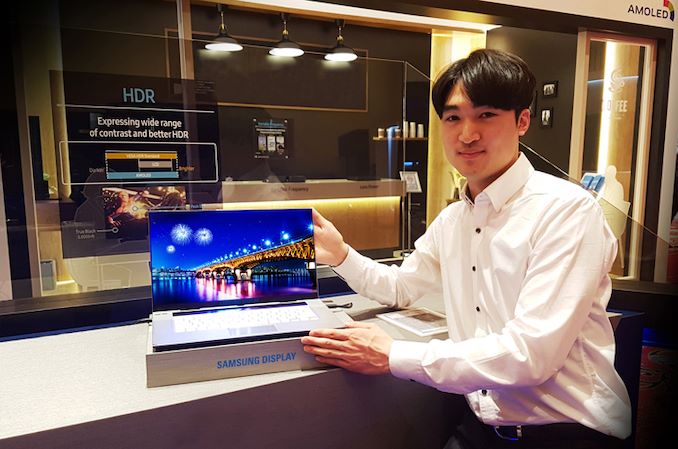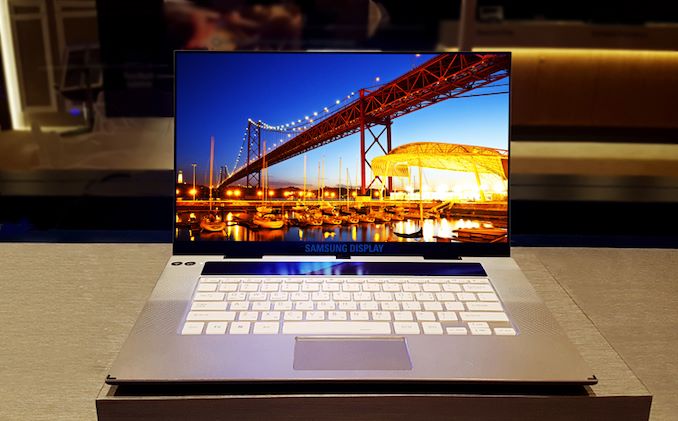Samsung Unveils 15.6-Inch Ultra-HD OLED Display for Laptops
by Anton Shilov on January 24, 2019 12:00 PM EST
Samsung has announced its 15.6-inch OLED monitor for notebooks. The Ultra-HD display features very advanced specs, will go into mass production next month, and will be used by leading makers of high-end notebooks later this year.
The Samsung 15.6-inch OLED monitor for notebooks relies on an Ultra-HD (3840×2160) OLED panel that boasts with a brightness level ranging from 0.0005 to 600 nits, a dynamic contrast ratio of 120,000:1, a very low response time, and wide horizontal viewing angles. The display can reproduce 100% of the DCI-P3 color gamut, which is considerably more more accurate when compared to LCDs available today. Furthermore, the monitor carries VESA’s DisplayHDR True Black badge thus supporting at least HDR10 spec.
| Specifications of Samsung's 15.6-Inch OLED Panel | |
| Specs | |
| Panel | 15.6" OLED |
| Native Resolution | 3840 × 2160 |
| Maximum Refresh Rate | ? |
| Response Time | unknown |
| Brightness | 0.0005 to 600 cd/m² |
| Contrast | 120,000:1 |
| Viewing Angles | ? |
| HDR | DisplayHDR True Black, HDR10 |
| Pixel Pitch | 0.0899 mm² |
| Pixel Density | 282 ppi |
| Display Colors | ? |
| Color Gamut Support | DCI-P3: 100% |
| Aspect Ratio | 16:9 |
| Mass Production Start | Mid-February-2019 |
An added bonus of any OLED monitor are very narrow display bezels, which will enable makers of notebooks to further miniaturize their 15.6-inch class laptops. In the meantime, keep in mind that the OLED technology is not ideal and has its own weaknesses, including off-axis color shifting, ghosting, burn-in, and other. So, only time will tell how good the new display from Samsung is.
Samsung will start mass production of its 15.6-inch OLED monitors for laptops in mid-February, so expect actual notebooks that use the display to hot the market later this year.
Back at CES, Lenovo and HP announced plans to use 15.6-inch AMOLED panels with their premium laptops in 2019, but did not confirm the source of their monitors.
Related Reading
- Lenovo at CES 2019: Yoga C730 Gets AMOLED Display
- HP at CES 2019: HP Spectre x360 15 Gets AMOLED Display
- Dell at CES 2019: Alienware 55-Inch 4K 120 Hz OLED Gaming Monitor Showcased
- New 8K OLED Displays for Tablets and Laptops: 8.3 and 13.3 Inches
- CES 2019: LG Announces Signature OLED TV R - A Rollable TV
- Lenovo Launches ThinkPad X1 Yoga At CES With OLED Display
- JOLED Demos 21.6-Inch OLED Monitor for Gamers
Source: Samsung











38 Comments
View All Comments
piroroadkill - Friday, January 25, 2019 - link
Also, "Never fails - there are always people trying to bring down better display technologies like plasma or OLED".Nope, I shit on OLED because it's a technology that degrades rapidly, regardless of what new name they slap on it.
Gunbuster - Friday, January 25, 2019 - link
My phone is one in a million I guess.WatcherCK - Thursday, January 24, 2019 - link
Im curious how oled equipped will protect head-up-arse users who like to pick their laptops up by their screens (crack...oh ah it just spontaneously cracked not sure why... 🙄) or whether that wont be an issue given how flexible oled tv screens appear to be...willis936 - Thursday, January 24, 2019 - link
YESYESBISON.aviwillis936 - Thursday, January 24, 2019 - link
That definitely was not meant to be a reply to a comment.Lau_Tech - Thursday, January 24, 2019 - link
Good to see that the market will now have another choice.TristanSDX - Friday, January 25, 2019 - link
MS will solve buri in problem with 'negative display mode'Gunbuster - Friday, January 25, 2019 - link
It's going to be funny when the displays are looking straight out of blade runner or a pacman cabinet at year 8 or 10... Oh right they go to the landfill at year 2 anyway...SaturnusDK - Monday, January 28, 2019 - link
Let me just bury the burn in on laptops debate. I've had an HP Spectre x360 with a 1440p 13.3" OLED display for 2½ years now. After I initially got it I adjust the colour gamut to 100% Adobe RGB enabled dark mode where possible and naturally set it to hide the taskbar. It still is 100% Adobe RGB after 30 months of daily use for at least 10 hours a day, and probably nearing 14 hours per day as it's my daily use laptop. I had the battery replaced for free as part of the HP extended warranty program before the 2 year factory warranty expired but actually had no problems with it at all.The key part here is that laptops by default shuts down the screen after a few minutes of not using it. This is done to preserve battery but it at the same time basically all but makes burn in impossible unless you are deliberately turning off all the features that exist to prevent it.
heymrdj - Tuesday, January 29, 2019 - link
But I use my laptop for productivity. I reference the static parts of the screen all day. I'm lucky if I can sleep the screen for 5 minutes every two hours...This may work for your couch surfer who really does fine with a tablet or phone but is using a windows PC, but for the most part Windows PC's (with their start bar at the bottom) are going to need the screen to stay on much longer than that, and not burn in.